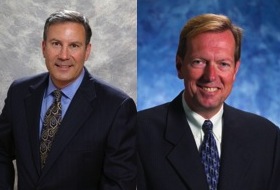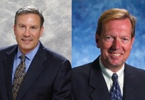In today’s Executive Interview, Steve Handschuh, president and chief operating officer of the Automotive Aftermarket Suppliers Association (AASA), and Bill Long, executive vice president, AASA, talk about the impact that the recent passage of the Right to Repair Act in Massachusetts (and the possibility of a similar national agreement) will have on the automotive aftermarket supplier industry. They also discuss the role the supplier industry played in moving Right to Repair forward in Massachusetts. 
The impact of the passage of the Right to Repair bill in Massachusetts for independent repair shops and consumers is clear-cut. However, passage of the bill affects the supplier industry as well. Please tell us what passage of the bill means for AASA and its supplier members.
Steve Handschuh: “The passage of ‘Right to Repair’ legislation in Massachusetts is a very positive development in the history of this issue. It is the beginning of a spirit of unprecedented cooperation and collaboration between vehicle manufacturers, dealerships and the independent automotive aftermarket.
“As full-service manufacturers, AASA member companies provide quality parts through a wide variety of distribution channels. With this new era of cooperation between all parties, repair professionals will continue to have access to the information and diagnostics needed to do the complete repair job whether at dealerships or independent repair shops.”
Bill Long: “Another important avenue opened by this legislation is collaboration between the tool and diagnostic equipment manufacturers, many of which are active AASA member companies, and OEMs. Continued cooperation will level the playing field in this sector and ultimately make affordable diagnostic tools available to a wider range of independent shops.
“In the final analysis, increased communication among all the industry partners is good for all aftermarket channel partners’ businesses: more customers at independent shops and more demand for quality replacement parts.”
You have noted that AASA and its members supported and applaud passage of the bill. Tell us about the important role the AASA supplier member community played in lobbying efforts for Right to Repair in Massachusetts, and/or on a national scale.
SH: “AASA and the Motor & Equipment Manufacturers Association (MEMA) fully support the right of American consumers to have motor vehicle service performed at the repair location of their choice. AASA and MEMA also believe independent repair shops and replacement parts suppliers must have access to the necessary information to diagnose, service and provide replacement parts for the repair of all motor vehicles.
“Based on the belief that private sector-based cooperation by all stakeholders is the best way to ensure consumers’ right to repair and adequate provision of all necessary repair information to the independent aftermarket, AASA has worked to keep open the lines of communications between all parties involved in the Right to Repair issue.
“In Massachusetts, AASA worked behind the scenes to help in keeping stakeholders in discussions to reach legislation that all could support. For example, it is critical that the aftermarket diagnostic tool suppliers have continued access to parametric data needed to develop the software vital to producing tools needed to diagnose and repair late model vehicles. Language that addressed this need was added to the bill after discussions with all parties to the agreement. The final language was developed by a supplier working group of AASA members.
“AASA’s efforts on this issue were not for the aggrandizement of the association or its leaders, but in support of its aftermarket supplier members. These companies have borne a significant portion of the costs associated with the Right to Repair campaign – the credit belongs to them. They deserve recognition for their value in achieving this success.”
BL: “I know that, in addition to funding the campaign, many suppliers have provided vital technical expertise and resources on this subject. I have personal experience supporting R2R from the supplier perspective – I had been deeply involved in the fight at its very beginning, battling for access to calibration codes necessary for independent shops to maintain OBDII equipped vehicles. Then and now, a tremendous number of suppliers have worked behind the scenes to help achieve this success.” [Editor’s note: Prior to joining AASA in June, Long had previously served as executive vice president, North American operations, and officer for Proliance International and began his career at Echlin.]
“Suppliers have been able to speak to legislators and government officials about the financial realities of this issue. The need for technical information has impacted business in the aftermarket industry from the independent repair facility through the distribution chain to the manufacturer – and ultimately impacted consumers’ freedom to choose where to have their vehicles serviced and repaired. With the help of our members, AASA was been able to propose language that is agreeable to all parties, yet protects the aftermarket industry as a whole.”
There is talk that the various constituents on both sides of the bill may now sit down to work out a national agreement based on the Massachusetts legislation. Will AASA and its members be involved, and if so, how?
SH: “AASA and its members will be actively involved in efforts to reach a nationwide agreement promoting collaboration and communication among all stakeholders. It is in our industry’s best interests to be self-governing and proactive in resolving issues rather than relying on government intervention.
“That is why AASA has been an active participant in the National Automotive Service Task Force (NASTF) for many years – I currently serve on the NASTF Board of Directors. NASTF was established in 2000 to identify, communicate and resolve gaps in the availability and accessibility of automotive service information, service training, diagnostic tools and equipment for the benefit of automotive service professionals and their customers.
“NASTF’s role has been recognized in several sections of the Massachusetts legislation, notably the NASTF Service Information Request (SIR) Internet-based problem resolution service and the NASTF Secure Data Release Model (SDRM). While it takes no position on any proposed or pending legislation at the state or national level, NASTF will be an important partner in the process and AASA will continue to support its efforts.”
AASA over the past several years has sought to develop a closer relationship between suppliers and technicians through the Know Your Parts campaign. Can the Know Your Parts campaign play a part in this as well and again, if so how?
SH: “AASA’s Know Your Parts campaign will be a vital partner in continuing the momentum of this new spirit of industry cooperation. It supports the automotive aftermarket’s long tradition of providing high-quality replacement parts and service to vehicle owners.
“Since the economic downturn, automotive service providers and their parts suppliers have been challenged to remain profitable in an increasingly competitive and price-conscious marketplace. At the same time, recent consumer surveys have shown that drivers are keeping their vehicles longer and prefer to have them repaired and serviced at independent repair shops.
“AASA members are reaching out to automotive service providers through the Know Your Parts campaign to ensure that they and vehicle owners receive the best parts, service and value available.”
BL: “The Know Your Part slogan, ‘It’s What’s Inside That Counts,’ is based on this assurance. Just as in Right to Repair, repair professionals and motorists have a right to know what’s in the box. AASA member companies invest heavily in technology development, testing, application research and engineering to ensure their products are high-quality and operate seamlessly in vehicles of all type and makes. Because of this, they are eager to tell their story through the Know Your Parts campaign. They know their reputation and the reputation of each repair professional depends on it.
“To support this effort, the Know Your Parts campaign will soon launch a new informational ‘portal’ website designed specifically for service professionals. It will serve as a vehicle to communicate valuable manufacturer-member technical and product information, an important component of ‘what else is inside the box.
“At the end of the day, it’s all about making accessible the information suppliers, distributors and repair professionals need that will continue to provide motorists the freedom of choice and convenience in vehicle maintenance, which in turn will keep AASA members and the industry strong.”














